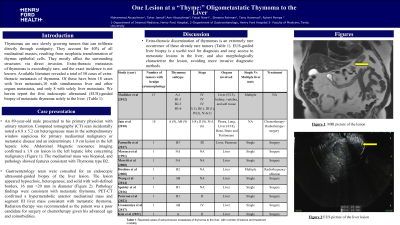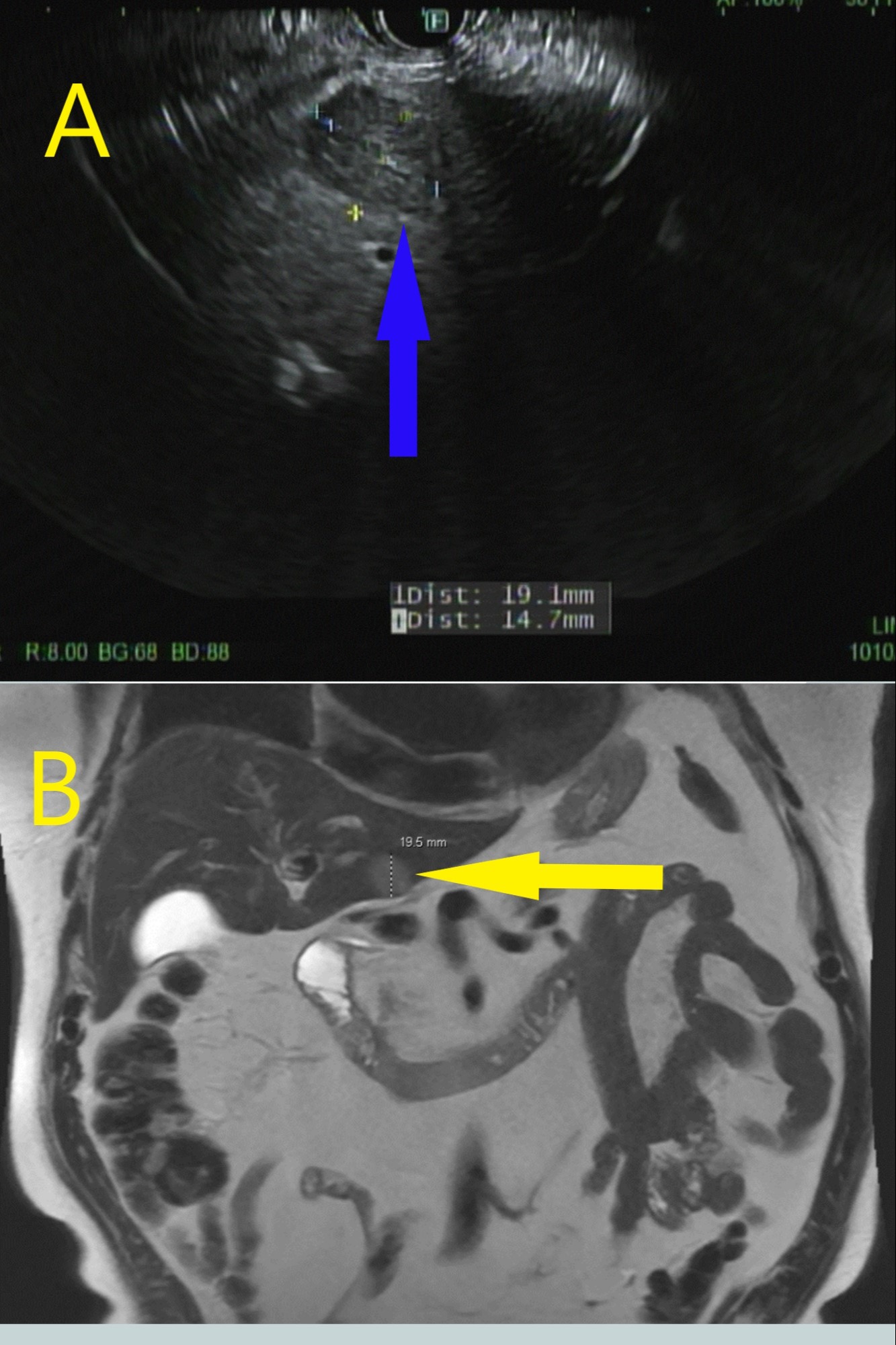Monday Poster Session
Category: Liver
P3040 - One Lesion at a “Thyme:” Oligometastatic Thymoma to the Liver
Monday, October 28, 2024
10:30 AM - 4:00 PM ET
Location: Exhibit Hall E

Has Audio

Mohammed Abusuliman, MD
Henry Ford Health
Detroit, MI
Presenting Author(s)
Mohammed Abusuliman, MD1, Taher Jamali, MD2, Amr Abusuliman, MD3, Faisal Nimri, MD2, Sheema Rehman, DO2, Tariq Hammad, MD2, Robert Pompa, MD1
1Henry Ford Health, Detroit, MI; 2Henry Ford Hospital, Detroit, MI; 3Tanta University, Qutour, Al Gharbiyah, Egypt
Introduction: Thymomas are rare slowly growing tumors that can infiltrate directly through contiguity. They account for 40% of all mediastinal masses, resulting from neoplastic transformation of thymus epithelial cells. They mostly affect the surrounding structures via direct invasion. Extra-thoracic metastasis of thymomas is exceedingly rare, and the exact incidence is not known. Available literature revealed a total of 50 cases of extra-thoracic metastasis of thymoma. Of these have been 18 cases with liver metastasis,10 with simultaneous liver and other organs metastasis, and only 8 with solely liver metastasis. We herein report the first endoscopic ultrasound (EUS)-guided biopsy of metastatic thymoma solely to the liver.
Case Description/Methods: An 89-year-old male presented to his primary physician with urinary retention. Computed tomography (CT) scan incidentally noted a 6.8 x 5.2 cm heterogeneous mass in the aortopulmonary window suspicious for primary mediastinal malignancy or metastatic disease and an indeterminate 1.9 cm lesion in the left hepatic lobe. Abdominal Magnetic resonance imaging confirmed a 1.9 cm lesion in the left hepatic lobe concerning malignancy (Figure 1-B). The mediastinal mass was biopsied, and pathology showed features consistent with Thymoma type B2.
Gastroenterology team were consulted for an endoscopic ultrasound-guided biopsy of the liver lesion. The lesion appeared hypoechoic, heterogenous, and solid with well-defined borders, 16 mm ×20 mm in diameter (Figure 1-A). Pathology findings were consistent with metastatic thymoma. PET-CT confirmed a hypermetabolic anterior mediastinal mass and segment III liver mass consistent with metastatic thymoma. Radiation therapy was recommended as the patient was a poor candidate for surgery or chemotherapy given his advanced age and comorbidities.
Discussion: Extra-thoracic dissemination of thymomas is an extremely rare occurrence of these already rare tumors (Table 1). EUS-guided liver biopsy is a useful tool for diagnosis and easy access to metastatic lesions in the liver, and also morphologically characterize the lesion, avoiding more invasive diagnostic methods.

Note: The table for this abstract can be viewed in the ePoster Gallery section of the ACG 2024 ePoster Site or in The American Journal of Gastroenterology's abstract supplement issue, both of which will be available starting October 27, 2024.
Disclosures:
Mohammed Abusuliman, MD1, Taher Jamali, MD2, Amr Abusuliman, MD3, Faisal Nimri, MD2, Sheema Rehman, DO2, Tariq Hammad, MD2, Robert Pompa, MD1. P3040 - One Lesion at a “Thyme:” Oligometastatic Thymoma to the Liver, ACG 2024 Annual Scientific Meeting Abstracts. Philadelphia, PA: American College of Gastroenterology.
1Henry Ford Health, Detroit, MI; 2Henry Ford Hospital, Detroit, MI; 3Tanta University, Qutour, Al Gharbiyah, Egypt
Introduction: Thymomas are rare slowly growing tumors that can infiltrate directly through contiguity. They account for 40% of all mediastinal masses, resulting from neoplastic transformation of thymus epithelial cells. They mostly affect the surrounding structures via direct invasion. Extra-thoracic metastasis of thymomas is exceedingly rare, and the exact incidence is not known. Available literature revealed a total of 50 cases of extra-thoracic metastasis of thymoma. Of these have been 18 cases with liver metastasis,10 with simultaneous liver and other organs metastasis, and only 8 with solely liver metastasis. We herein report the first endoscopic ultrasound (EUS)-guided biopsy of metastatic thymoma solely to the liver.
Case Description/Methods: An 89-year-old male presented to his primary physician with urinary retention. Computed tomography (CT) scan incidentally noted a 6.8 x 5.2 cm heterogeneous mass in the aortopulmonary window suspicious for primary mediastinal malignancy or metastatic disease and an indeterminate 1.9 cm lesion in the left hepatic lobe. Abdominal Magnetic resonance imaging confirmed a 1.9 cm lesion in the left hepatic lobe concerning malignancy (Figure 1-B). The mediastinal mass was biopsied, and pathology showed features consistent with Thymoma type B2.
Gastroenterology team were consulted for an endoscopic ultrasound-guided biopsy of the liver lesion. The lesion appeared hypoechoic, heterogenous, and solid with well-defined borders, 16 mm ×20 mm in diameter (Figure 1-A). Pathology findings were consistent with metastatic thymoma. PET-CT confirmed a hypermetabolic anterior mediastinal mass and segment III liver mass consistent with metastatic thymoma. Radiation therapy was recommended as the patient was a poor candidate for surgery or chemotherapy given his advanced age and comorbidities.
Discussion: Extra-thoracic dissemination of thymomas is an extremely rare occurrence of these already rare tumors (Table 1). EUS-guided liver biopsy is a useful tool for diagnosis and easy access to metastatic lesions in the liver, and also morphologically characterize the lesion, avoiding more invasive diagnostic methods.

Figure: Figure 1: EUS picture of the liver lesion (Panel A, Blue arrow), MRI picture of the lesion (Panel B, yellow arrow)
Note: The table for this abstract can be viewed in the ePoster Gallery section of the ACG 2024 ePoster Site or in The American Journal of Gastroenterology's abstract supplement issue, both of which will be available starting October 27, 2024.
Disclosures:
Mohammed Abusuliman indicated no relevant financial relationships.
Taher Jamali indicated no relevant financial relationships.
Amr Abusuliman indicated no relevant financial relationships.
Faisal Nimri indicated no relevant financial relationships.
Sheema Rehman indicated no relevant financial relationships.
Tariq Hammad indicated no relevant financial relationships.
Robert Pompa indicated no relevant financial relationships.
Mohammed Abusuliman, MD1, Taher Jamali, MD2, Amr Abusuliman, MD3, Faisal Nimri, MD2, Sheema Rehman, DO2, Tariq Hammad, MD2, Robert Pompa, MD1. P3040 - One Lesion at a “Thyme:” Oligometastatic Thymoma to the Liver, ACG 2024 Annual Scientific Meeting Abstracts. Philadelphia, PA: American College of Gastroenterology.
